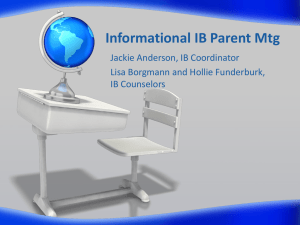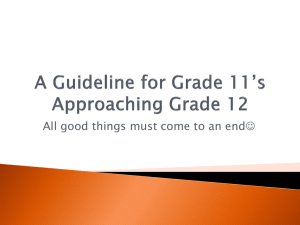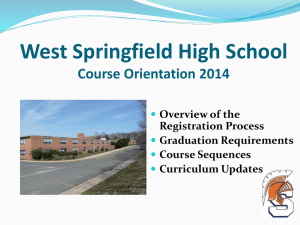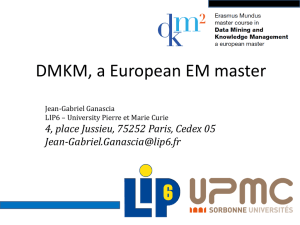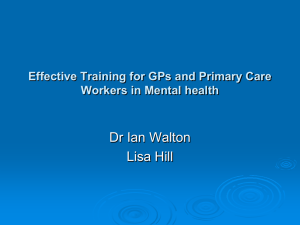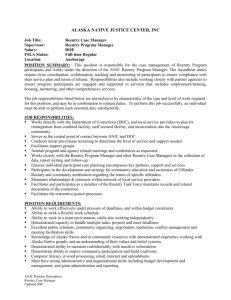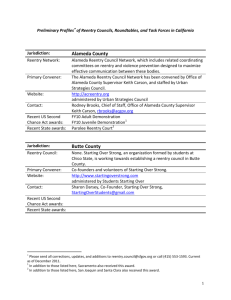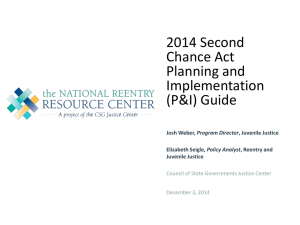The Characteristics of Reentry Programs for Out-of
advertisement
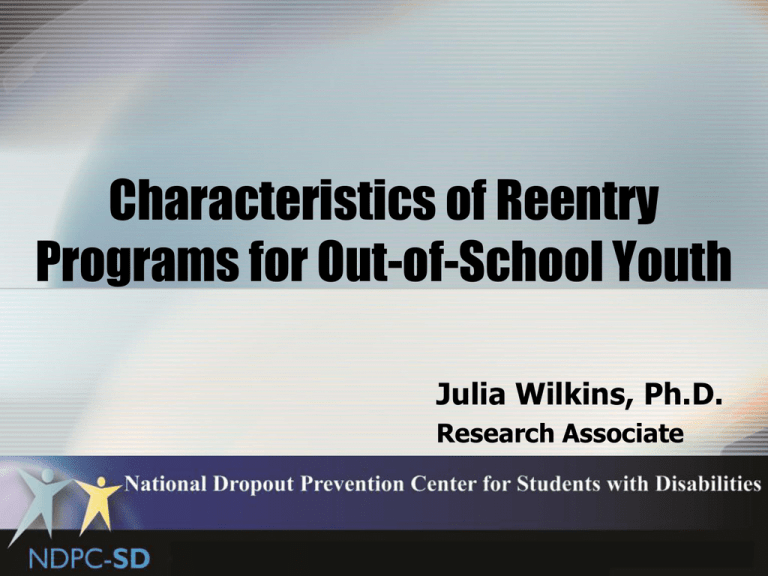
Characteristics of Reentry Programs for Out-of-School Youth Julia Wilkins, Ph.D. Research Associate Works-in-Progress • Review of recovery initiatives • Review of reentry programs • Definitions – How are dropout reentry and recovery defined in your state/school district? Need for a Broad Range of Options • The variety of reasons that students drop out makes it difficult to implement a uniform approach to reentry • Many students who drop out have a long history of course failure and retention (Kaufman & Bradby, 1992; Roderick, 1993), and returning to school to obtain a high school diploma may therefore seem like an unachievable goal • Students who repeated a grade and are significantly overage may feel embarrassed to return to school • Students who drop out often had poor relationships with teachers and may even believe teachers wanted them to leave (Croninger & Lee, 2001; Fine, 1991; Jordan & McPartland, 1994; Rumberger, 1995) • Lack of close relationships with teachers can lead students to feel alienated and disconnected from school (Cooper & Liou, 2007; Le Compte & Dworkin, 1991) and students are unlikely to want to return to same environment • Many students drop out because classes are not perceived as interesting (Bridgeland, DiIulia, & Burke Morison, 2006) • Personal and family situations may have forced students to drop out Credit Needs • Most students who reenroll in traditional public schools do not earn enough course credits upon reenrollment to graduate within 5 years • Of students who reenrolled in the San Bernardino City Unified School District over a 5-year period, only 18% ultimately earned a diploma, representing just 6% of the students who dropped out (Berliner, Barrat, Fong, & Shirk, 2008) • The Denver Public Schools and Colorado Youth for a Change (CYC) analyzed data from students who dropped out of high school in the 2006-2007 school year and found that only 3% of students were in situations where they could easily return to the traditional school system (28% of 17-20 years olds had very few credits) Reentry Programs • Specifically attempt to address the barriers students face in returning to and remaining in school – child care for parenting students – self-paced classes for working students • Learning is placed in real-world contexts – work experience, service learning • Small class sizes • Partnerships with community-based organizations Options for Returning Youth High school diploma and associate’s degree High school diploma/GED and work experience alternative schools charter schools community-based schools online schools adult education programs adult high schools alternative programs for youth with specific needs dual enrollment high school/college programs community colleges High school diploma and industryrecognized credentials GED and postsecondary education School District-Specific Options • Los Angeles Unified School District – Continuation high schools, Alternative Education Work Centers (AEWC) • New York City Public Schools – Young Adult Borough Centers, Learning to Work programs • School District of Philadelphia – Accelerated high schools, Educational Options Program • Portland Public Schools – Alternative programs that offer credit recovery, credit for proficiency, and credit for work/volunteer experience Initiatives to Locate and Reenroll Students Phone Calls/ Home visits Community-Wide Campaigns Information Sharing Between Schools District Teams Volunteers School Teams Collaboration with Community-Based Organizations Reengagement / Transition Centers Contracted Organizations Print and Electronic Media Non-Profit CommunityBased Organizations School Expos/ Reengagement Fairs Characteristics of Reentry Programs flexible programming options for credit recovery and accrual meaningful curricula additional services and support staff involvement partnerships Flexible Programming Benefits Features • • • • • • • • Year-round enrollment Classes in the evenings and/or on Saturdays Classes in morning, afternoon, and evening sessions Classes in various locations Online courses Self-paced curricula Variety of course delivery modes (e.g., project-based, independent study) Alternative modes of course completion (e.g., portfolios) • • • • • Students can return to school at any time Flexible timetabling enables students with other commitments to attend school Self-paced courses allow students to succeed even if they cannot maintain regular attendance Overage students are more likely to attend school at alternative sites than reenroll in traditional high schools A variety of instructional and assessment techniques can accommodate individual learning styles Examples of Flexible Programming • Portland Public Schools, Oregon – Alliance High Schools operates on four campuses, including two night schools for working and parenting students and a school with a technical education focus at which students can participate in job shadowing and internships • Diploma Plus Schools in Indiana – Offer flexible scheduling, flexibility in course titles and construction of courses, alternative instructional media, and competency-based route to high school diploma (Arlington High School) • Youth Connection Charter School (YCCS) – 22 community-based campuses around Chicago that offer portfoliobased course completion, dual enrollment in high school and community college programs, evening programs, and targeted programs for gang-involved, pregnant, and parenting youth Options for Credit Recovery and Accrual Benefits Features • • • • • Opportunities to earn high school and college credits through dual enrollment at high school and community college Opportunities to obtain a diploma and industry-recognized credentials Credit for internships/work experience Credit for community service Self-paced online credit-recovery programs (available at school or alternative location with credits transferred to home school) • • • • Students who are overage can obtain high school diploma in timely fashion and make headway into occupational certificate or associate’s degree Students can earn credits while developing employment skills Students can earn industry qualifications that increase their chances of gaining employment Online courses can be taken from any location with internet access Examples of Options for Credit Recovery and Accrual • Online Credit Recovery – At The Arkansas Virtual High School students can take supplemental courses and have credits transferred to their home school – Houston Independent School District has “Grad Labs” (computer labs with self-paced online credit-recovery program) at 46 school campuses • Gateway to College – 24 colleges in 14 states at which students can complete high school diploma requirements while simultaneously earning college credits Meaningful Curricula Benefits Features • • • • • • Academic instruction combined with training for industryrecognized credentials Opportunities for on-the-job training School-to-work internships Service learning projects Mentors and instructors from local businesses Instruction in “soft skills” needed for employment • • • • • Students can see connection between education and “real life” Students can gain qualifications that provide entry to the workforce Students can gain exposure to work practices and related employment skills Service learning gives students sense of civic responsibility Recipients of service learning projects gain from students’ contributions Examples of Meaningful Curricula • Rosemary Anderson High in Portland, Oregon – Students work towards high school diploma while participating in job shadowing and paid internships with local businesses • Gonzalo Garza Independence High School in Austin, Texas – In addition to job shadowing and internships with local nonprofit organizations, students can take a multi-credit course in horticulture and sell herbs at a local farmer’s market • Baltimore City Career Academy in Maryland – Academics, work experience, and “soft skills” needed for employment are addressed through an integrated curriculum Additional Services and Support Benefits Features • • • • • Additional academic instruction (e.g., individualized tutoring) Classes in areas such as parenting, life skills, and conflict resolution Services such as child care, counseling, and substance abuse Case managers to coordinate additional services Mentors to provide ongoing support during transition to college or employment • • • • • Students can get individualized support in areas of academic weakness Students can learn additional skills needed for the workplace (e.g., anger management, appropriate dress) Barriers toward attendance can be minimized Services can help to address needs of the entire family Assistance with obtaining employment or attending college can be individualized Examples of Additional Services and Support • Los Angeles Conservation Corps – Operates 3 charter schools that provide counseling, mentoring, and job search coaching services. • EDCO Youth Alternative in Boston – Counselors from Wediko Children’s Services provide conflict resolution and crisis management services, The Higher Education Information Center provides college preparation, The Boston Private Industry Council (PIC) provides career counseling. • Youth Opportunities (YO) program in Baltimore – Staff provides SAT preparation, postsecondary information, and college tours. Students with disabilities are referred for vocational services at Sinai Hospital where they receive job-seeking skills, direct employment, and case management. Staff Involvement Benefits Features • • • • • • Collaborative meetings between teachers, parents, and students to establish students’ learning goals Close teacher monitoring of students’ behavior and academic performance Teams consisting of various school personnel to help address students’ problems Attention to instructional/credit needs as well as day-to-day needs Staff who is accessible both in school and after school hours Staff to provide ongoing contact and support for students • • • • • Students’ educational programs can be individually tailored to meet their needs Involved staff can make referrals to appropriate outside resources and services Students who got “lost in the crowd” in previous high schools feel increased sense of support and belonging Mentors can motivate students to graduate from school Students can be given personal guidance to help them transition to postsecondary education or employment Examples of Staff Involvement • Academy of Scholastic Achievement (ASA), a Youth Connection Charter School (YCCS) campus in Chicago – At the beginning of each school year, teachers, parents, and students collaborate to develop students’ individual learning plans. The plans outline students’ learning and behavioral objectives, as well as teacher expectations and potential barriers to students’ success. • Austin Independence School District (AISD) in Texas – Each school campus has a task force that intervenes when students experience attendance, academic, or behavioral problems. Task force members include principals, counselors, nurses, dropout prevention specialists, regular classroom teachers, and special education teachers. • The Reengagement Center in Philadelphia – Staff evaluates students’ academic needs and directs them to appropriate academic programs, as well as other supports. E.g., Advisors from the City’s Office of Mental Health meet with youth to conduct clinical interviews, assess their behavioral health needs, and make behavioral health referrals. Partnerships Benefits Features • • • • • Local businesses for onsite job training and internships Local colleges to allow for dual enrollment Community-based organizations to provide alternate settings at which students can take classes Local organizations to increase students’ access to community resources Social service agencies to provide services for particularly vulnerable groups of youth • • • • • Students can simultaneously gain diploma and vocational experience/qualifications Students can earn college credits while working toward high school diploma Students can make smooth transition into postsecondary education Students can get access to a variety of community resources Students’ varied needs outside of school setting can be met Examples of Partnerships • Partnership between Los Angeles Unified School District (LAUSD) and the Los Angeles Community College District (LACCD) enables every LAUSD student to take at least one college transfer or career/technical course before leaving high school. • In Vermont, partnership between high schools and Learning Works, the statewide adult education and literacy system, enables students to complete high school diploma through service providers in the community. • New York City Department of Education operates Learning to Work in • The Horizonte Instruction and Training Center in Salt Lake City has partnerships collaboration with Good Shepherd Services (GSS). GSS staff provides supervision for students in the workplace and a year of follow-up support. with local government agencies, businesses, and community-based organizations to host resource fairs and seminars on topics such as employment, housing, and banking. Also provides meals to students and their children through partnership with the Utah Food Bank. Next Steps • Review characteristics of reentry programs for particularly vulnerable groups of youth • Develop database of reentry programs • Create groundwork for future research Upcoming Publications • Reentry Programs for Particularly Vulnerable Groups of Youth – – – – – – – – – – African American and Hispanic/Latino Native American English Language Learners Foster Care Juvenile Justice Homeless Lesbian, Gay, Bisexual, and Transgender (LGBT) Substance Abusers Mental Health Needs Teen Parents Database of Reentry Programs • Will be available on National Dropout Prevention Center for Students with Disabilities website www.ndpc-sd.org Contact Information Dr. Julia Wilkins NDPC-SD 209 Martin St. Clemson, SC 29631 Tel: 864.656.2595 Email: wilkin6@clemson.edu
